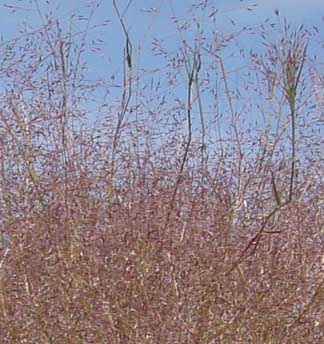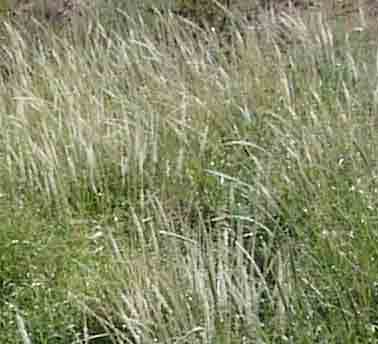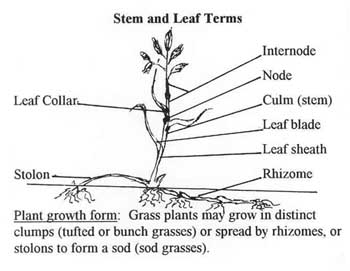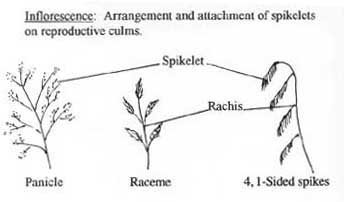 ....
....
Grasses (Poaceae)
Main Sources: Gould, Frank, 1951, Grasses of the Southwestern United States, Tucson: University of Arizona Press; Shreve, Forrest & Ira Wiggins, 1964, Vegetation and Flora of the Sonoran Desert, Vol. 1, Palo Alto: Stanford University Press; Kearney, Thomas & Robert Peebles, et al., 1960, Arizona Flora, Berkeley: University of California Press; McClaran, Mitchel & Thomas Van Devender, 1995, The Desert Grassland, Tucson: University of Arizona Press; van Devender, Thomas & Mark Dimmitt, "Desert Grasses", in Phillips, Steven & Patricia Comus, eds., 2000, A Natural History of the Sonoran Desert, pp. 265-80, Arizona-Sonora Desert Museum Press, Tucson; Ruyle, George & Deborah Young, eds., 1997, Arizona Range Grasses, Tucson, University of Arizona College of Agriculture; USDA Conservation Districts of Southeastern Arizona,, n.d., Grasses of Southeastern Arizona. Washington, DC Parker, Kitti, 1972, An Illustrated Guide to Arizona Weeds, Tucson: University of Arizona Press; Redfern, Ron, 2001, Origins: the Evolution of Continents, Oceans, and Life, University of Oklahoma Press, pp 228-231; Goff, Stephen & John Salmeron, 2004, "Back to the Future of Cereal", Scientific American August: 42-49.
This page focuses on the nature (and varieties) of grasses per se. For discussion of the relationship of our part of the United States Southwest to ecoregional "grasslands", see the relevant subheading under this link: San Pedro Flora Today. A link to Apache Highlands Grasslands may also prove useful.
Today, members of the grass family (Poaceae) are found in nearly every environment on earth, comprising some 10,000 species with more individual plants and a wider environmental range than any other plant type. Grasses now dominate vast areas of the earth's surface, providing food and shelter for many varieties of animals, and humans depend on them hugely --rice, wheat, and corn, all grasses, today account for most of the world's human caloric intake, and barley, millet, sorghum, as well as sugarcane are also grasses). But grasses were rare -- bamboo are the most primitive types (first appearing around 58 Million years ago, with the expansion of deciduous forests, reflecting an increase of seasonal dry periods) -- until about 30 Million years ago, following a global cooling and widespread drying of climate which favored their increase. Current genetic studies are showing that all grasses are far more interrelated than was previously thought.
Grasses are flowering plants (Angiosperms), but their flowers are very small, simple, not very attractive to pollinators -- instead, grasses (setting aside the domesticated species, which humans selected for non-seed-dispersal) rely on winds to disperse their pollens and seeds. As global climate dried beginning in the Late Oligocene Epoch (ca 25 mya, when in North America, rise of the Rockies produced extensive rain shadows), in the drier lands winds proved very effective broadcasters, and grasses also adapted to recovery from fire in these dry-land conditions.
In addition, many grasses have evolved to spread vegetatively by creeping stems. Unlike trees and most herbs, they possess a primary stem that grows along the surface of the ground (a stolon), or even underground as in bamboo (rhizomes). This protects the growing tip of the plant from grazers and from cold. As a result of these advantages, grasses spread into what had previously been forested regions, and various herbivores began evolving toward specialization on grass diets. Several groups of today's mammals owe major features of their bodies to their commitment to grasslands.
Grass stems are constructed of cellulose reinforced by silica, and since tooth enamel is softer than silica, herbivore teeth wear down when animals graze these plants. Modern ungulates thus evolved cheek teeth that grow continuously and resist abrasion, and -- since cellulose is not easily digested -- they also evolved distinctive stomachs for processing this new kind of food. Grasses, in turn, evolved to continue growing even after severe grazing or cropping (the perennial "bunch grasses" for example die back to their perennial crowns or roots under conditions of drought, frost, fire, or grazing, then grow back from basal stems -- they are perhaps the ultimate type of deciduous plant adaptation, being "whole plant deciduous" [Devender & Dimmit, op. cit., p 267]). And since grasses produce open terrains, over time herbivores developed greater mobility to traverse these wide-open spaces, and their carnivores had to follow suit, evolving modern fauna more adapted for speed (than were such earlier creatures on our lands such as the Brontotherium). All of this co-evolution accelerated during the last 15 MYa, when grasslands came to dominate many of the earth's ecosystems and modern-looking herbivores and carnivores emerged along with them. It is a remarkable (and surprising) fact that so many of our modern fauna have appeared so recently (see Age of the Earth), and largely in response to the spread of grasslands. Nearly all temperate region grasses are eaten by grazing animals, and seeds of many were used as food by Native Americans (as by many other humans in other parts of the world).
To provide a basis for describing our grasses, we follow the terminology and imagery provided by the USDA (cited above) -- though we will avoid specialist terms as much as possible:
 Grasses have distinctively jointed stems -- round or flattened (never triangular), usually hollow except at the nodes (where the leaves arise). Their leaves -- which usually arise singly at each node and are spaced alternatively on opposite sides of the stem -- are composed of a sheath enclosing the stem and a blade (the broader, expanded part).
Grasses have distinctively jointed stems -- round or flattened (never triangular), usually hollow except at the nodes (where the leaves arise). Their leaves -- which usually arise singly at each node and are spaced alternatively on opposite sides of the stem -- are composed of a sheath enclosing the stem and a blade (the broader, expanded part).
The roots may include reproductive extensions called rhizomes or stolons.

The flowers of grasses are individual, simple florets, lacking petals and grouped in "inflorescences" (varieties indicated at right). We will not use all these specialized terms, but the distinction between "panicle" and "spike" seems useful. These kinds of differences are obvious when viewing a field of plants.

Again, the details and terminology of grass flowers shown here are more than we need for our own amateur work, but the terms "floret" and "spikelet" at least become more referential with these images, and the size and distribution of "awns" (bristles or stiff hairs at the ends of flower parts) are important.
Desert grasses have evolved a number of distinctive features, including their modes of photosynthesis (the distinction between C-3 and C-4 pathways), and their responses to drought/frost/fire/grazing -- in perennials, dying back to the crown or root; in annuals, dying to seed; (though some of these grasses appear to be transitional between "perennial" and "annual"). These adaptations enable them to respond quickly to more propitious conditions when rains return. One of the most valuable properties of our grasses (especially our perennials) is of course their ability to stabilize desert soils.
C-3 and C-4 Grasses
To avoid technical discussions beyond the skill of the writer, let it suffice to say that these two types of grasses differ in the way they obtain carbon dioxide from the atmosphere. C-4 grasses have a preliminary stage enabling them to multiply the carbon dioxide concentrations in their cells, which enables their leaf pores to remain closed longer, thus reducing water loss through transpiration. Since they have greater photosynthetic capacity and water efficiency at high temperature, they are much more common in desert grasslands than elsewhere: more than 95% of our grass production is from grasses having the C-4 pathway (McClaran op. cit., p. 14-15). For a comprehensive listing of Arizona desert grasses, see the "Poaceae" at University of Arizona Agriculture.
The following list includes our most important general types:
Grama (Bouteloua spp.)
Muhly; Deergrass (Muhlenbergia spp.)
Arizona Cottontop (Digitaria californica)
Plains Bristlegrass (Setaria)
Sacaton (Sporobolus spp.)
Dropseed (Sporobolus spp.)
Tanglehead (Heteropogon contortus)
Three-awn (Aristida spp.)
Oryzopsis (rice grass)
Stipa (needle grass)
Hilaria spp. (tobosa et al.) -- important in Arizona; second only to grama, but not prominent in our area.
The following list includes other members of the grass family, including various annuals, non-natives, etc:
Feather Fingergrass
See also our Invasive Species page
Back to Information & Images